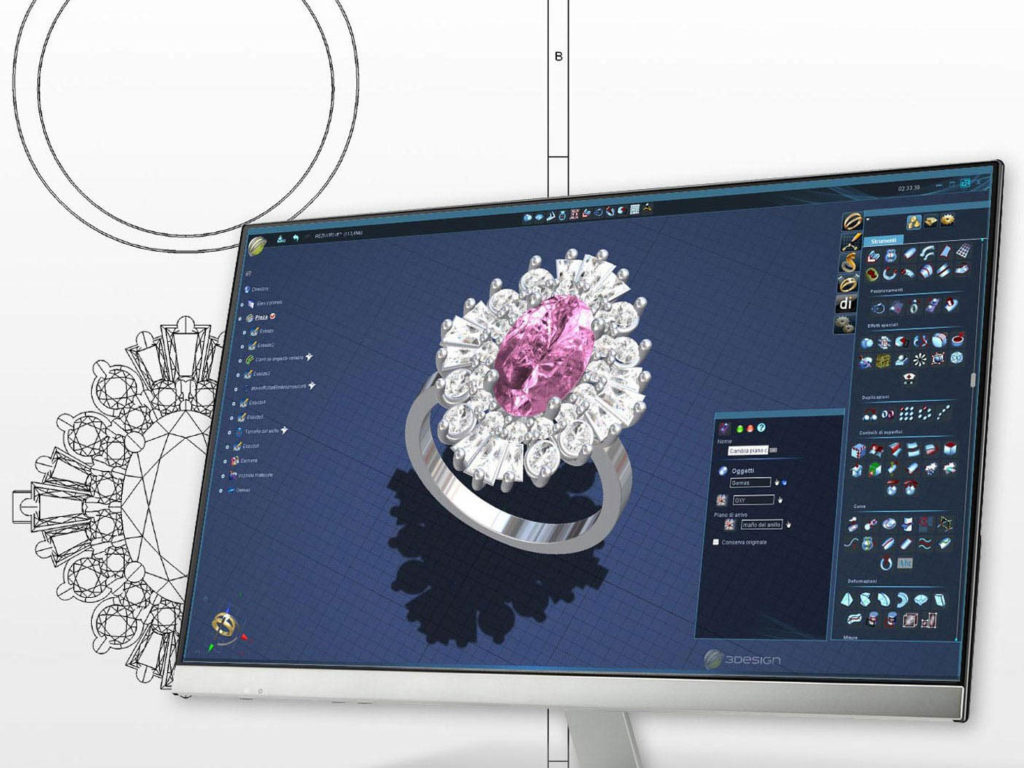3D printing for jewellery design is a fast-growing field and one that is creative, demanding and extremely rewarding. With the possibility to print jewellery in precious metals, plastics and even wood, with 3D printing for jewellery you can produce imaginative pieces in a range of materials, whether it’s for bespoke design or fashion jewellery.
Learning to model for 3D printing gives you the opportunity to learn in-demand skills in the industry and print your own designs – so how can you get started?
Here, our BAJ CAD tutor Jack Meyer discusses the industry of 3D printing and how you can start learning the skills to print your own jewellery, too.
First developed in the 1980s, 3D printing has become an essential and versatile manufacturing tool in recent years. It has revolutionised production processes across a wide range of industries, including jewellery making. And with research into the technology’s capabilities booming, the list of materials that can be 3D printed is growing all the time: from plastic, resin and rubber, to wood, metal and wax – the possibilities really are endless!
“There’s a reason why jewellers and manufacturers get so excited about the prospect of being able to use 3D printing. It’s because there’s so many things it can be used for, and they keep coming up with more ways of using it by the day,” explains Jack Meyer, Senior CAD Tutor at the British Academy of Jewellery.
Looking forward, the future of CAD (computer-aided design) and 3D printing in the jewellery industry looks sure to be even more exciting and dynamic. The development of haptic devices is giving designers the power to physically feel objects that don’t yet exist, while next-generation rendering tools are allowing jewellery models on screen to be photographed as though they were a physical piece in a real photo studio.
Learning computer-aided design (CAD) to create models for 3D printing therefore not only gives you access to a fast-growing area of highly adaptable design and manufacturing technology, but also provides you with a transferable, in-demand skillset which will become more relevant as time goes on.
For jewellers who work on bespoke pieces, in particular, CAD has dramatically transformed the process of reworking models. The technology makes it significantly cheaper, faster and easier to make alterations and adjustments in line with a customer’s evolving needs and desires.
“In the ’90s if you wanted to get a bespoke ring done, you’d have to go to Bond Street and the entry cost would be £25,000,” says Jack. “Now we can make all the changes we want on CAD, on a computer screen, and we can rework it and rework it, and the cost of the revisions is just basically man hours and time. It’s gotten so cheap we take it for granted. And so what used to be a £25,000 ring, we can now get for £900.”
It’s no surprise then that a recent study found that 99% of all bespoke design in the UK involves CAD. Some companies even outsource these activities when none of their in-house designers have the necessary skills.
In order to start creating your own designs for 3D printing, you’ll need to learn CAD. But with multiple CAD programs available, how should you choose which one to use?
Jack has some pointers on this front too: You shouldn’t feel that committing to a particular CAD software will limit your prospects, he says. Acquiring skills with one system is a first step that will only make moving on to use other software easier, opening up a world of new possibilities for jewellery design and manufacturing.
BAJ has selected 3Design for its 3D modelling course due to the flexibility offered by its parametric modelling tools, which make it one of the most useful CAD softwares available to jewellery makers, especially those specialising in bespoke designs. As Jack explains, the programme’s unique history feature, for example, will allow you to work and rework your models with ease – a function not offered by all CAD software.
Still, Jack says, what’s most important is to find the right tool for your needs – so if you aren’t sure which one to choose, ask users of the software for their thoughts – and BAJ tutors will also help you choose the course or software that will help you meet your goals.
View this post on InstagramA post shared by British Academy of Jewellery (@britishacademyofjewellery) on

Learn the fundamental skills you need for transferring your hand drawing abilities to Adobe Illustrator in order to produce eye-catching, fully rendered jewellery designs. Our Adobe Illustrator classes are ideal for working or aspiring jewellery designers looking to make a move into CAD, an invaluable skill for the contemporary jewellery industry.
By the end of the programme, you will have an effective Adobe Illustrator workflow, enabling you to take your scanned jewellery drawings and transform them into hand-rendered jewellery images.

On this 3Design CAD for Jewellery course you will learn to model and render jewellery designs in 3D with 3Design Atelier, gaining confidence in producing objects that can be brought to life through 3D printing or jewellery casting.
Led by BAJ’s CAD experts, our 3Design CAD for Jewellery: Beginner course is ideal for current or aspiring jewellery designers who need to rework their fine CAD jewellery designs on a regular basis, and will teach them how to use 3Design’s powerful parametric modelling tools to quickly make dramatic changes to existing models.
Telephone: +44 (0)20 7405 0197
Company Registration Number:
05992037

Be the first to hear about competitions and giveaways, events, special offers and exclusive discounts, new course dates, and other updates from BAJ and its sister company Free2Learn.